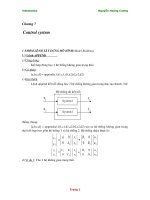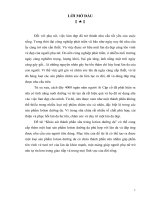Field trip — sat march 18th
Bạn đang xem bản rút gọn của tài liệu. Xem và tải ngay bản đầy đủ của tài liệu tại đây (1.63 MB, 20 trang )
Field trip — Sat. March 18th
Driver who can take 3 passengers?
Bring a pen, hand lens, lunch and water (~1L)
Wear layers — prepare for wet, windy conditions
…rain jacket, umbrella?, sweatshirt…
Wear shoes with good tread
…hiking boots, good tennis shoes,
or wellies (your feet might get wet)
Eclogite formation
along fractures —
Gabbro was
metastable
Granulite-eclogite transition
Bergen Arcs, Norway
Chapter 22: A Classification of
Metamorphic Rocks
• Metamorphic rocks are classified on the basis of
texture and composition (either mineralogical or
chemical)
• Unlike igneous rocks, which have been plagued by a
proliferation of local and specific names,
metamorphic rock names are surprisingly simple and
flexible
• May choose some prefix-type modifiers to attach to
names if care to stress some important or unusual
textural or mineralogical aspects
Chapter 22: Foliated
Metamorphic Rocks
• Foliation: and planar fabric element
• Lineation: any linear fabric elements
– They have no genetic connotations
– Some high-strain rocks may be foliated, but
they are treated separately
Chapter 22: Foliated
Metamorphic Rocks
Cleavage
– Traditionally: the property of a rock to split along
a regular set of sub-parallel, closely-spaced
planes
– A more general concept adopted by some
geologists is to consider cleavage to be any type
of foliation in which the aligned platy
phyllosilicates are too fine grained to see
individually with the unaided eye
Chapter 22: Foliated
Metamorphic Rocks
Schistosity
– A preferred orientation of inequaint mineral grains
or grain aggregates produced by metamorphic
processes
– Aligned minerals are coarse grained enough to
see with the unaided eye
– The orientation is generally planar, but linear
orientations are not excluded
Chapter 22: Foliated
Metamorphic Rocks
Gneissose structure
– Either a poorly-developed schistosity or
segregated into layers by metamorphic
processes
– Gneissose rocks are generally coarse grained
Chapter 22: Foliated
Metamorphic Rocks
Slate: compact, very finegrained, metamorphic rock
with a well-developed
cleavage. Freshly cleaved
surfaces are dull
Phyllite: a rock with a
schistosity in which very fine
phyllosilicates
(sericite/phengite and/or
chlorite), although rarely
coarse enough to see unaided,
impart a silky sheen to the
foliation surface. Phyllites
with both a foliation and
lineation are very common
a
b
Figure 22-1. Examples of foliated metamorphic rocks. a. Slate. b. Phyllite. Note the difference in reflectance on the foliation
surfaces between a and b: phyllite is characterized by a satiny sheen. Winter (2001) An Introduction to Igneous and Metamorphic
Petrology. Prentice Hall.
Chapter 22: Foliated
Metamorphic Rocks
Schist: a metamorphic rock
exhibiting a schistosity. By
this definition schist is a
broad term, and slates and
phyllites are also types of
schists. In common usage,
schists are restricted to those
metamorphic rocks in which
the foliated minerals are
coarse enough to see easily in
hand specimen.
Figure 22-1c. Garnet muscovite schist. Muscovite crystals are visible and silvery, garnets occur as large dark porphyroblasts.
Winter (2001) An Introduction to Igneous and Metamorphic Petrology. Prentice Hall.
Chapter 22: Foliated
Metamorphic Rocks
Gneiss: a metamorphic rock
displaying gneissose
structure. Gneisses are
typically layered (also called
banded), generally with
alternating felsic and darker
mineral layers. Gneisses may
also be lineated, but must
also show segregations of
felsic-mineral-rich and darkmineral-rich concentrations.
Figure 22-1d. Quartzo-feldspathic gneiss with obvious layering. Winter (2001) An Introduction to Igneous and Metamorphic
Petrology. Prentice Hall.
Chapter 22: Specific
Metamorphic Rock Types
Serpentinite: an ultramafic rock metamorphosed at low grade,
so that it contains mostly serpentine.
Greenschist/Greenstone: a low-grade metamorphic rock that
typically contains chlorite, actinolite, epidote, and albite. Note
that the first three minerals are green, which imparts the color
to the rock. Such a rock is called greenschist if foliated, and
greenstone if not. The protolith is either a mafic igneous rock
or graywacke.
Amphibolite: a metamorphic rock dominated by hornblende +
plagioclase. Amphibolites may be foliated or non-foliated. The
protolith is either a mafic igneous rock or graywacke.
Chapter 22: Specific
Metamorphic Rock Types
Blueschist: a blue amphibole-bearing metamorphosed
mafic igneous rock or mafic graywacke. This term is
so commonly applied to such rocks that it is even
applied to non-schistose rocks.
Eclogite: a green and red metamorphic rock that
contains clinopyroxene and garnet (omphacite +
pyrope). The protolith is typically basaltic.
Figure 21-1. Metamorphic field gradients (estimated P-T conditions along surface traverses directly up metamorphic grade)
for several metamorphic areas. After Turner (1981). Metamorphic Petrology: Mineralogical, Field, and Tectonic Aspects.
McGraw-Hill.
Fig. 25-3.
Temperaturepressure diagram
showing the three
major types of
metamorphic
facies series
proposed by
Miyashiro (1973,
1994). Winter
(2001) An
Introduction to
Igneous and
Metamorphic
Petrology.
Prentice Hall.
Metamorphic Facies
Fig. 25-2. Temperaturepressure diagram
showing the generally
accepted limits of the
various facies used in this
text. Boundaries are
approximate and
gradational. The
“typical” or average
continental geotherm is
from Brown and Mussett
(1993). Winter (2001) An
Introduction to Igneous
and Metamorphic
Petrology. Prentice Hall.
Paired Metamorphic Belts of Japan
Metamorphic Facies
• Table 25-1. The definitive mineral assemblages that
characterize each facies (for mafic rocks).
Table 25-1. Definitive Mineral Assemblages of Metamorphic Facies
Facies
Definitive Mineral Assemblage in Mafic Rocks
Zeolite
zeolites: especially laumontite, wairakite, analcime
Prehnite-Pumpellyite
prehnite + pumpellyite (+ chlorite + albite)
Greenschist
chlorite + albite + epidote (or zoisite) + quartz ± actinolite
Amphibolite
hornblende + plagioclase (oligoclase-andesine) ± garnet
Granulite
orthopyroxene (+ clinopyrixene + plagioclase ± garnet ±
hornblende)
Blueschist
glaucophane + lawsonite or epidote (+albite ± chlorite)
Eclogite
pyrope garnet + omphacitic pyroxene (± kyanite)
Contact Facies
After Spear (1993)
Mineral assemblages in mafic rocks of the facies of contact metamorphism do not differ substantially from that of the corresponding
regional facies at higher pressure.
Fig. 25-9. Typical mineral changes that take place in metabasic rocks during progressive metamorphism in the
medium P/T facies series. The approximate location of the pelitic zones of Barrovian metamorphism are included
for comparison. Winter (2001) An Introduction to Igneous and Metamorphic Petrology. Prentice Hall.
Fig. 26-19. Simplified petrogenetic grid for metamorphosed mafic rocks showing the location of several determined
univariant reactions in the CaO-MgO-Al2O3-SiO2-H2O-(Na2O) system (“C(N)MASH”). Winter (2001) An
Introduction to Igneous and Metamorphic Petrology. Prentice Hall.






